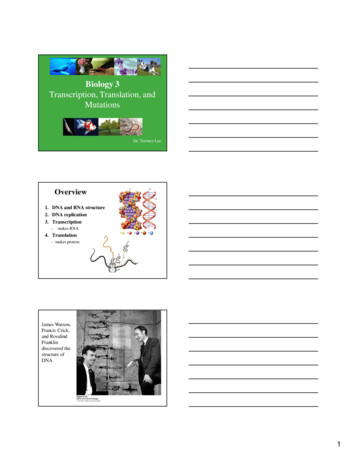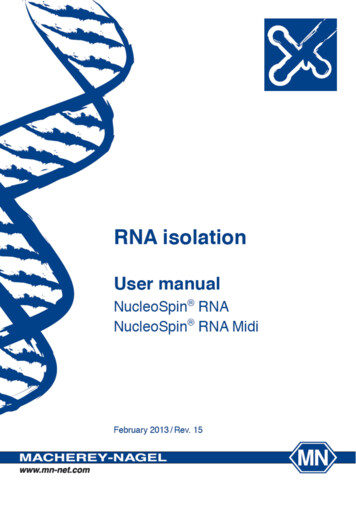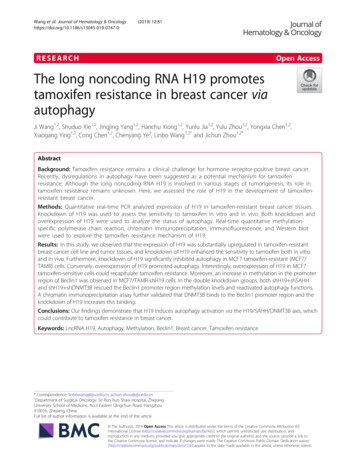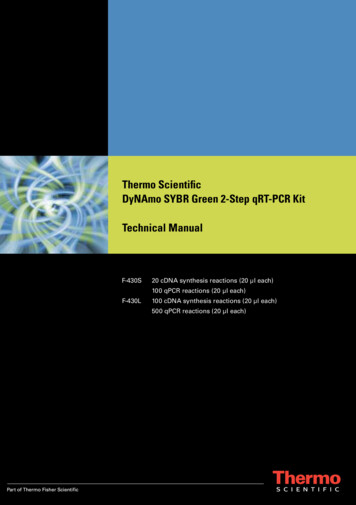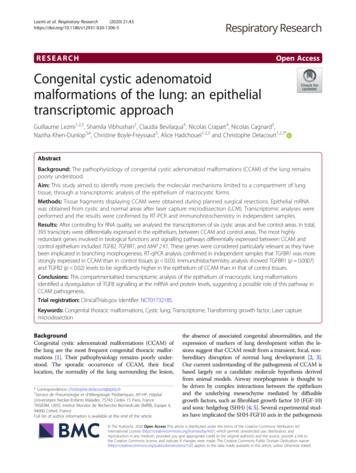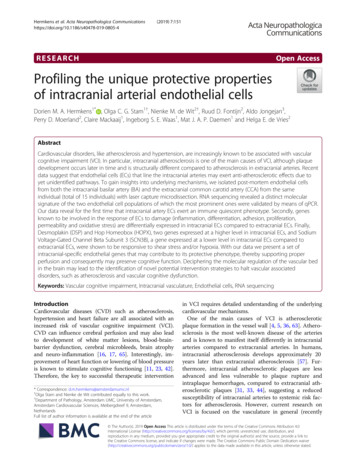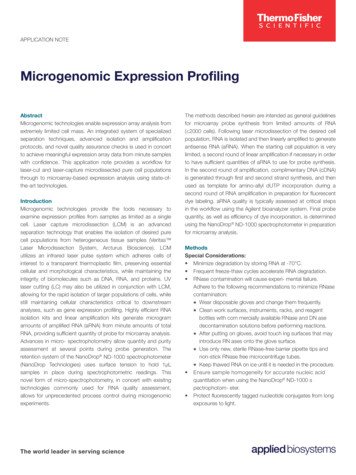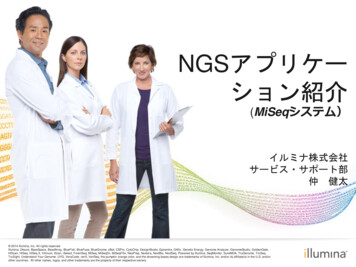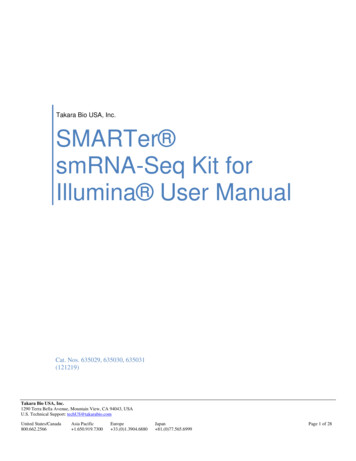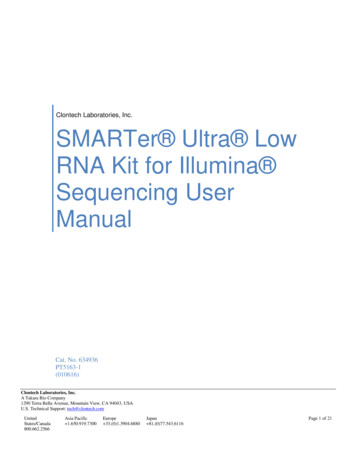
Transcription
Clontech Laboratories, Inc.SMARTer Ultra LowRNA Kit for Illumina Sequencing UserManualCat. No. 634936PT5163-1(010616)Clontech Laboratories, Inc.A Takara Bio Company1290 Terra Bella Avenue, Mountain View, CA 94043, USAU.S. Technical Support: ia Pacific 1.650.919.7300Europe 33.(0)1.3904.6880Japan 81.(0)77.543.6116Page 1 of 21
SMARTer Ultra Low RNA Kit for Illumina Sequencing User ManualTable of ContentsI.List of Components . 4II.Additional Materials Required . 5III. Introduction . 6IV. SMARTer cDNA Synthesis . 9A.Requirements for Preventing Contamination . 9B.General Requirements . 9C.Sample Recommendations . 10D.Sample Requirements . 10E.Protocol: First-Strand cDNA Synthesis . 11F.Protocol: Purification of First-Strand cDNA using SPRI Ampure Beads . 13G.Protocol: ds cDNA Amplification by LD PCR . 14V.Amplified cDNA Purification & Validation . 15A.Protocol: Purification of ds cDNA using SPRI Ampure Beads . 15B.Validation Using the Agilent 2100 BioAnalyzer . 16VI. Covaris Shearing . 17A.Protocol: Covaris Shearing of Full-length cDNA . 17VII. Appendix A: PCR Clean Work Station Guidelines . 17A.Equipment Needed in the PCR Clean Work Station . 17B.PCR Clean Work Station Operation Instructions. 18VIII. Appendix B: Working with Cells. 19A.Protocol: Screen for Cell Culture Media . 19B.Cell Preparation for First-Strand cDNA Synthesis . 19IX. Appendix C: PCR Optimization . 19X.Appendix D: Troubleshooting Guide . 20XI. References . 21(010616)www.clontech.comClontech Laboratories, Inc. A Takara Bio CompanyPage 2 of 21
SMARTer Ultra Low RNA Kit for Illumina Sequencing User ManualTable of FiguresFigure 1. Protocol Overview . 6Figure 2. Flowchart of SMARTer cDNA synthesis. . 7Figure 3. SMART Adapter in Primer 2 Read . 8Figure 4. Optional setup to ensure proper and steady positioning of tubes containing first-strand cDNA. 13Figure 5. Electropherogram example results from Agilent 2100 Bioanalyzer. 16Table of TablesTable 1. Sample Preparation Guidelines . 11Table 2. Cycling Guidelines Based on Amount of Starting Material . 14Table 3. Process Configuration Panel Set Up . 17Table 4. Validated Media . 19Table 5. Troubleshooting Guide for SMARTer cDNA Synthesis & Amplification . 20(010616)www.clontech.comClontech Laboratories, Inc. A Takara Bio CompanyPage 3 of 21
SMARTer Ultra Low RNA Kit for Illumina Sequencing User ManualI.List of ComponentsThe following components have been specifically designed to work together and are optimized for this particularprotocol. Please do not make any substitutions. The substitution of reagents in the kit and/or a modification of theprotocol may lead to unexpected results.The SMARTer Ultra Low RNA Kit for Illumina Sequencing (Cat. No. 634936) consists of: The Advantage 2 PCR Kit (Cat. No. 639206), which has been specially formulated to provideautomatic hot-start PCR (Kellogg et al., 1994)—and can efficiently amplify full-length cDNAs with asignificantly lower error rate than that of conventional PCR (Barnes, 1994).The SMARTer Ultra Low RNA Kit for Illumina Sequencing Components (Cat. No. 634948), which includes:Box 1:10 x 20 µl SMARTer II A Oligonucleotide (12 µM)5 µl Control Total RNA (1 µg/µl)Box 2:200 µl 3’ SMART CDS Primer II A (12 µM)250 µl IS PCR Primer (12 µM)400 µl 5X First-Strand Buffer (RNase-Free)250 mM Tris-HCl (pH 8.3)375 mM KCl30 mM MgCl2400 µl dNTP Mix (dATP, dCTP, dGTP, and dTTP, each at 10 mM)100 µl Dithiothreitol (DTT; 100 mM)200 µl SMARTScribe Reverse Transcriptase (100 U/µl)10 ml Nuclease-Free Water550 µl RNase Inhibitor (40 U/µl)10 ml Dilution Buffer10 ml Purification Buffer (10 mM Tris-Cl, pH 8.5)Storage Conditions (010616)Store Control Total RNA and SMARTer IIA Oligonucleotide at –70 C.Store Dilution Buffer at –20 C. Once thawed, the buffer can be stored at 4 C.Store Purification Buffer at –20 C. Once thawed, the buffer can be stored at Room Temperature.Store all other reagents at –20 C.www.clontech.comClontech Laboratories, Inc. A Takara Bio CompanyPage 4 of 21
SMARTer Ultra Low RNA Kit for Illumina Sequencing User ManualII.Additional Materials RequiredThe following reagents are required but not supplied. These materials have been validated to work with thisprotocol. Please do not make any substitutions because you may not obtain the expected results: Single channel pipette: 10 μl, 20 μl and 200 μl, one eachEight channel pipette: 20 μl and 200 μl, one eachFilter pipette tips: 10 μl, 20 μl and 200 μl, one box eachOne QuickSpin minicentrifuge for 1.5-ml tubesOne QuickSpin minicentrifuge for 0.2-ml tubesOne marker penSmall 1.5-ml tube rackOne bag of 8-strip nuclease-free 0.2-ml thin wall PCR tubes with capsDNA-OFF Solution (Takara Cat. No. 9036)For PCR Amplification & Validation: One dedicated PCR thermal cycler used only for first-strand synthesisHigh Sensitivity DNA Kit (Agilent Cat No. 5067-4626)IsoFreeze Flipper Rack (MIDSCI Cat. No. TFL-20)IsoFreeze PCR Rack (MIDSCI Cat. No. 5640-T4)Nuclease-free thin-wall PCR tubes (0.2 ml; USA Scientific Cat. No.1402-4700)Nuclease-free nonsticky 1.5-ml tubes (USA Scientific Cat. No. 1415-2600)For SPRI Bead Purification: Agencourt AMPure PCR Purification Kit(5 ml Beckman Coulter Part No. A63880; 60 ml Beckman Coulter Part No. A63881)Use this kit for the SPRI Purifications (Sections IV.F & V.A).MagnaBot II Magnetic Separation Device (Promega Part No. V8351)Use this stand for the first purification (Section IV.F).Magnetic Stand-96 (Ambion Part No. AM10027)Use this stand for the second purification (Section V.A).96-well V-bottom Plate (500 μl; VWR Cat. No. 47743-996)MicroAmp Clean Adhesive Seal (AB Part No. 4306311)80% EthanolFor Sequencing Library Generation: (010616)Low Input Library Prep Kit (Cat. No. 634947)Covaris Instrument and Related Materials for DNA Shearingwww.clontech.comClontech Laboratories, Inc. A Takara Bio CompanyPage 5 of 21
SMARTer Ultra Low RNA Kit for Illumina Sequencing User ManualIII.IntroductionSMARTer cDNA Synthesis for the Illumina Sequencing PlatformThe SMARTer Ultra Low RNA Kit allows high-quality cDNA synthesis starting from as little as 10 pg of totalRNA or cells. The kit has been designed and validated to prepare cDNA samples for sequencing and quantitationwith the Illumina HiSeq and Genome Analyzer sequencing instruments. The entire library constructionprotocol can be completed within two days (see Figure 1 for an overview of the protocol). SMART technologyoffers unparalleled sensitivity and unbiased amplification of cDNA transcripts, enabling a direct start from yoursample. Most importantly, SMART technology enriches for full-length transcripts and maintains the truerepresentation of the original mRNA transcripts; these factors are critical for transcriptome sequencing and geneexpression analysis.Start with Total RNA or Cells(Section IV.C)SMARTer First-strand cDNA Synthesis &Purification(Sections IV.E & IV.F)(Section IV.G)Day OneFull Length ds cDNA Amplification by LD-PCRAmplified cDNA Purification & Validation(Sections V.A & V.B)Covaris Shearing of Full-Length cDNA(Section VI)Library preparationDay TwoUsing the Low Input Library Prep Kit (Cat. No. 634947)Cluster GenerationFigure 1. Protocol Overview.(010616)www.clontech.comClontech Laboratories, Inc. A Takara Bio CompanyPage 6 of 21
SMARTer Ultra Low RNA Kit for Illumina Sequencing User ManualSMARTer cDNA synthesis starts with picogram amounts of total RNA. A modified oligo(dT) primer (theSMART CDS Primer) primes the first-strand synthesis reaction (Figure 2). When SMARTScribe ReverseTranscriptase reaches the 5’ end of the mRNA, the enzyme’s terminal transferase activity adds a few additionalnucleotides to the 3’ end of the cDNA. The carefully-designed SMARTer Oligonucleotide base-pairs with thenon-template nucleotide stretch, creating an extended template to enable SMARTScribe RT continue replicatingto the end of the oligonucleotide (Chenchik et al., 1998). The resulting full-length, single-stranded (ss) cDNAcontains the complete 5’ end of the mRNA, as well as sequences that are complementary to the SMARTerOligonucleotide. In cases where the RT pauses before the end of the template, the addition of non-templatenucleotides is much less efficient than with full-length cDNA/RNA hybrids, thus the overhang needed for basepairing with the SMARTer Oligonucleotide is absent. The SMARTer anchor sequence and the poly A sequenceserve as universal priming sites for end-to-end cDNA amplification. In contrast, cDNA without these sequences,such as prematurely terminated cDNAs, contaminating genomic DNA, or cDNA transcribed from poly A– RNA,will not be exponentially amplified. However, truncated RNAs with poly A tails that are present in poor qualityRNA starting material will be amplified yielding shorter cDNA fragments.Figure 2. Flowchart of SMARTer cDNA synthesis. The SMARTer II A Oligonucleotide, 3’ SMART CDS Primer II A, and IS PCRPrimer all contain a stretch of identical sequence (see Section I for sequence information).(010616)www.clontech.comClontech Laboratories, Inc. A Takara Bio CompanyPage 7 of 21
SMARTer Ultra Low RNA Kit for Illumina Sequencing User ManualSMART Adapter in Primer 2 ReadThe IS primer used for amplification of the double-stranded cDNA is blocked, which stops Illumina sequencing adapterligation at the 5’ ends of the ds cDNA fragments containing the SMART sequence. In many library preparation methods,the double-stranded Illumina adapters are added to the cDNA fragments through ligation. Unfortunately, in thesereactions, ligation takes place between the bottom strand of the cDNA fragment and the Illumina adapter containing ReadPrimer 2, at a low and somewhat variable rate. If ligation is also successful on the other, unblocked side of the samecDNA fragment, this bottom strand can be amplified by the subsequent PCR and can ultimately form clusters forsequencing on Illumina machines.Upon sequencing these clusters, the SMART adapter will be present in the first 30 cycles in Read 2 of an Illuminasequencing run. In addition, the dT30 sequence from the CDS primer will also be present after the adapter in a subset ofthese clusters. The presence of the SMART adapter in Read 2 commonly occurs at a high enough rate to be observed inthe base distribution by cycle graph generated by the run analysis (Figure 3, cycles 77-106), as does the dT30 sequence(Figure 3, cycles 107-136).If you are interested in avoiding sequencing the SMART adapter, there are three options:1. Sequence only from Read Primer 1.2. Use the Nextera or Nextera XT library preparation method.3. Use the Low Input Library Prep Kit (Cat. No. 634947). This unique adapter addition method does not allow forerroneous ligation.If you have already sequenced with Read Primer 2, the SMART adapter sequence can be trimmed from reads prior tomapping to your transcriptome.Figure 3. SMART Adapter in Primer 2 Read. The presence of the SMART adapter in Read 2 commonly occurs at a high enough rate to beobserved in the base distribution by cycle graph generated by the run analysis (cycles 77-106), as does the dT30 sequence (cycles 107-136).(010616)www.clontech.comClontech Laboratories, Inc. A Takara Bio CompanyPage 8 of 21
SMARTer Ultra Low RNA Kit for Illumina Sequencing User ManualIV.SMARTer cDNA SynthesisNOTE: Please read the entire protocol before starting. This protocol is optimized for the generation of cDNAstarting from ultra-low amounts of total RNA using Clontech’s SMART technology. The protocol also worksstarting from cells. Due to the sensitivity of the protocol, the input material (total RNA or cells) needs to becollected and purified under clean room conditions to avoid contamination. The whole process of SMARTercDNA Synthesis should be carried out in a PCR Clean Work Station under clean room conditions (see AppendixA: PCR Clean Work Station Guidelines).A.Requirements for Preventing Contamination B.General Requirements (010616)Before you set up the experiment, make sure you have two physically separated work stations.The first should be the PCR Clean Work Station (see Appendix A) for all Pre-PCR experimentsthat require clean room conditions such as first-strand cDNA synthesis (Section IV.E.) andpurification of first-strand cDNA (Section IV.F). The second work station can be in the generallaboratory where you will perform PCR, measure cDNA concentration, and work on any otherexperiments involving the PCR-amplified cDNA.It is absolutely required to have a PCR work station in a clean room with positive air flow, ascontamination may occur very easily. Once contamination occurs it can be difficult to remove.You need to strictly follow the clean room operation rules, i.e., you can only move materials/ suppliesfrom the clean room to the general lab, NOT the other way around. Don’t share anyequipment/reagents between the clean room and the general lab. You need a separate PCR machineinside the PCR workstation for cDNA synthesis.Wear gloves and sleeve covers throughout the procedure to protect your RNA samples fromdegradation by contaminants and nucleases. Be sure to change gloves and sleeve covers between eachsection of the protocol.The success of your experiment depends on the quality of your starting sample of RNA. Prior tocDNA synthesis, please make sure that your RNA is intact and free of contaminants.The assay is very sensitive to variations in pipette volume, etc. Please make sure all your pipettes arecalibrated for reliable delivery, and make sure nothing is attached to the outside of the tips.All lab supplies related to SMARTer cDNA synthesis need to be stored in a DNA-free, closedcabinet. Reagents for SMARTer cDNA synthesis need to be stored in a freezer/refrigerator that hasnot previously been used to store PCR amplicons.Add enzymes to reaction mixtures last, and thoroughly incorporate them by gently pipetting thereaction mixture up and down.Do not increase (or decrease) the amount of enzyme added or the concentration of DNA in thereactions. The amounts and concentrations have been carefully optimized for the SMARTeramplification reagents and protocol.If you are using this protocol for the first time we strongly recommend that you perform negative andpositive control reactions to verify that kit components are working properly.www.clontech.comClontech Laboratories, Inc. A Takara Bio CompanyPage 9 of 21
SMARTer Ultra Low RNA Kit for Illumina Sequencing User ManualC.Sample RecommendationsThe sequence complexity and the average length of SMARTer cDNA is noticeably dependent on thequality of starting RNA material. Due to the limiting sample size, most traditional RNA isolation methodsmay not be applicable. There are several commercially available products that enable purification of totalRNA preparations from extremely small samples [e.g. Clontech offers the NucleoSpin RNA XS Kit (Cat.No. 740902.10) for purification of RNA from 102 cells]. When choosing a purification method (kit)ensure that it is appropriate for your sample amount.Though SMART Technology is sensitive enough to generate cDNA from as little as 10 pg of total RNA,the use of a higher amount of starting material (100 pg to 10 ng) is recommended for reproducibleamplification of low abundance mRNA transcripts.After RNA extraction, if your sample size is not limiting, we recommend evaluating total RNA qualityusing the Agilent RNA 6000 Pico Kit (Cat. No. 5067-1513).D.Sample RequirementsTotal RNAThis protocol has been optimized for cDNA synthesis starting from 10 pg of total RNA. However, if yourRNA sample is not limiting, we recommend that you start with more total RNA (up to 10 ng). Purifiedtotal RNA should be in nuclease-free water. If the total RNA volume is larger than 1 μl, perform ethanolprecipitation and resuspend the pellet in 1 μl of nuclease-free water.CellsAlthough this protocol was optimized for cDNA synthesis starting from total RNA, the protocol has alsobeen validated to work starting from cells. See Appendix B: Working with Cells for instructions onselecting the appropriate media and preparing your cells for first-strand cDNA synthesis.(010616)www.clontech.comClontech Laboratories, Inc. A Takara Bio CompanyPage 10 of 21
SMARTer Ultra Low RNA Kit for Illumina Sequencing User ManualE.Protocol: First-Strand cDNA Synthesis(Perform in PCR Clean Work Station)IMPORTANT: To avoid introducing contaminants to your RNA sample, the first part of the cDNAsynthesis protocol (Sections E–G) requires use of a PCR work station in a clean room. Standard cleanroom procedure should be followed. If no clean room is available, you may work with just a PCR CleanWork Station on a temporary basis. We strongly recommend putting the PCR work station in a cleanroom to avoid contamination. It is critical to have an air blower in the PCR work station turned “on”during the whole process. Refer to Appendix A for PCR Clean Work Station Guidelines.1. Prepare a stock solution of Reaction Buffer by mixing the Dilution Buffer with the RNase Inhibitor asindicated below, scale-up as needed:19 μl1 μl20 μlDilution BufferRNase InhibitorTotal Volume2. See Table 1 for guidelines on setting up your control & test samples. Transfer each whole volume of3.5 μl to individual 0.2 ml RNase-free PCR tubes in an 8-well strip.Table 1. Sample Preparation GuidelinesComponentsReaction BufferNuclease-free waterDiluted Control RNA*SampleTotal VolumeNegative Control2.5 µl1 µl––3.5 µlPositive Control2.5 µl–1 µl–3.5 µlTest Sample2.5 µl––1 µl3.5 µl*The Control RNA is supplied at a concentration of 1 μg/μl. The Control RNA should be diluted innuclease-free water to match the concentration of your test sample. Perform serial dilutions on theControl RNA until you obtain the appropriate concentration.3. Place the samples on a –20 C prechilled IsoFreeze PCR rack in a PCR clean station, and add 1 μl of3’ SMART CDS Primer II A (12 μM). Mix the contents and spin the tube(s) briefly in amicrocentrifuge:3.5 μl1 μl4.5 μlCell/Total RNA in Reaction Buffer (from Table 1)3’ SMART CDS Primer II A (12 μM)Total Volume4. Incubate the tube(s) at 72 C in a hot-lid thermal cycler for 3 min, and then put the samples on theIsoFreeze PCR rack.NOTE: The initial reaction steps (Step 5-7) are critical for first-strand synthesis and should not bedelayed after Step 4. You can prepare your master mix (for Step 5) while your tubes are incubating(Step 4) in order to jump start the cDNA synthesis.(010616)www.clontech.comClontech Laboratories, Inc. A Takara Bio CompanyPage 11 of 21
SMARTer Ultra Low RNA Kit for Illumina Sequencing User Manual5. Meanwhile, prepare a Master Mix for all reactions plus one by combining the following reagents inthe order shown at room temperature:2 μl0.25 μl1 μl1 μl0.25 μl1 μl5.5 μl5X First-Strand BufferDTT (100 mM)dNTP Mix (10 mM)SMARTer IIA Oligonucleotide (12 µM)RNase InhibitorSMARTScribe Reverse Transcriptase (100 U)*Total Volume added per reaction* Add the reverse transcriptase to the master mix just prior to use. Mix well by gently vortexing andspin the tube(s) briefly in a microcentrifuge.6. Add 5.5 μl of the Master Mix to each reaction tube from Step 4. Mix the contents of the tube(s) bygently pipetting, and spin the tube(s) briefly to collect the contents at the bottom.7. Incubate the tubes at 42 C for 90 min.8. Terminate the reaction by heating the tube(s) at 70 C for 10 min.(010616)www.clontech.comClontech Laboratories, Inc. A Takara Bio CompanyPage 12 of 21
SMARTer Ultra Low RNA Kit for Illumina Sequencing User ManualF.Protocol: Purification of First-Strand cDNA using SPRI Ampure Beads(Perform in PCR Clean Work Station)The first-strand cDNA selectively binds to SPRI beads leaving contaminants in solution which isremoved by a magnetic separation. The beads are then directly used for PCR amplification.NOTES: Before use, beads should be brought to room temperature and mixed well to disperse. In order to ensure proper and steady positioning of the tubes containing first-strand cDNA (fromProtocol E), you may place the tubes in the top part of an inverted P20 or P200 Rainin Tip Holderwhich is taped to the MagnaBot II Magnetic Separator.Figure 4. Optional setup to ensure proper and steady positioning of tubes containing first-strand cDNA.To purify the SMART cDNA from unincorporated nucleotides and small ( 0.1 kb) cDNA fragments,follow this procedure for each reaction tube:1. Add 25 μl of SPRI Ampure XP beads to each sample using a 200 μl pipetter. Adjust the pipetterto 35 μl, and pipette the entire volume up and down 10 times to mix thoroughly. The beads areviscous; suck the entire volume up, and push it out slowly. Incubate at room temperature for 8minutes to let DNA bind to the beads.2. Briefly spin the sample tubes to collect the liquid from the side of the wall. Place the sampletubes on the Promega MagnaBot II Magnetic Separation Device for 5 min or longer, until thesolution is completely clear.3. While samples are still on the Magnetic Separation Device pipette out the solution and discard.Briefly spin the tubes to collect the liquid at the bottom.4. Place the tubes back in the Promega MagnaBot II Magnetic Separation Device for 2 min orlonger to let beads separate from the liquid completely. Pipette out the residual liquid from thebeads using a 10 μl pipetter and discard. Make sure that there is no supernatant remaining in thetube. Be careful not to take out any beads with the supernatant.(010616)www.clontech.comClontech Laboratories, Inc. A Takara Bio CompanyPage 13 of 21
SMARTer Ultra Low RNA Kit for Illumina Sequencing User ManualG.Protocol: ds cDNA Amplification by LD PCR(Perform steps 1 & 2 in PCR Clean Work Station)We strongly recommend use of the Advantage 2 PCR Kit (included in this kit; also sold separately asCat. Nos. 639206 & 639207) for PCR amplification. The Advantage 2 Polymerase Mix has been speciallyformulated for efficient and accurate amplification of cDNA templates by long-distance PCR (LD PCR;Barnes, 1994). Table 2 provides guidelines for optimizing your PCR, depending on the amount of totalRNA used in the first-strand synthesis.IMPORTANT: Optimal parameters may vary with different templates and thermal cyclers. To determinethe optimal number of cycles for your sample and conditions, we strongly recommend that you perform arange of cycles. Do not exceed the recommended cycle numbers in the table below for different startingamounts of material. Refer to Appendix C for PCR optimization guidelines.Table 2. Cycling Guidelines Based on Amount of Starting MaterialInput Amount,Total RNA10 ng1 ng500 pg100 pg10 pgInput Amount,Cells1,000 cells100 cells50 cells10 cells1 cellTypical No. ofPCR Cycles12121315181. Prepare a PCR Master Mix for all reactions, plus one additional reaction. Combine the followingreagents in the order shown, then mix well by vortexing and spin the tube briefly in amicrocentrifuge:5 μl2 μl2 μl2 μl39 μl50 μl10X Advantage 2 PCR BufferdNTP Mix (10 mM)IS PCR Primer (12 μM)50X Advantage 2 Polymerase MixNuclease-Free WaterTotal Volume per reaction2. Add 50 μl of PCR Master Mix to each tube containing DNA bound to the beads from Section IV.F.,Step 4. Mix well and briefly spin down.Important: Transfer the samples from the PCR Clean Work Station to the general lab. All downstreamprocesses will be performed in the general lab.3. Place the tube in a preheated thermal cycler with a heated lid. Commence thermal cycling using 3. thefollowing program:95 CXa cycles:95 C65 C68 C72 C4 C1 min15 sec30 sec6 min10 minforeveraConsultTable 2 for guidelines. Determine the optimal number of PCR cycles using the protocol inAppendix C: PCR Optimization.(010616)www.clontech.comClontech Laboratories, Inc. A Takara Bio CompanyPage 14 of 21
SMARTer Ultra Low RNA Kit for Illumina Sequencing User ManualV.Amplified cDNA Purification & ValidationA.Protocol: Purification of ds cDNA using SPRI Ampure BeadsPCR-amplified cDNA is purified by immobilizing it onto SPRI beads. The beads are then washed with80% Ethanol and eluted in Purification Buffer.1. Take out a 96-well Axygen V-bottom plate and cover all the wells with a MicroAmp Clean AdhesiveSeal. Uncover only the wells that you want to use. Vortex SPRI beads till even, and then add 90 μl ofSPRI Ampure XP Beads to the wells of the 96-well plate.2. Transfer the entire PCR product including the SPRI beads (from Section IV.G, Step 3) to the wells ofthe plate containing the SPRI beads (from Step 1 above). Pipette the entire volume up and down 10times to mix thoroughly. Incubate at room temperature for 8 min to let the DNA bind to the beads.NOTE: The beads are viscous; suck the entire volume up, and push it out slowly.3. Place the 96-well plate on the Ambion Magnetic Stand-96 for 5 min or longer, until the liquidappears completely clear, and there are no beads left in the supernatant.4. While the plate is sitting on the magnetic stand, pipette out the supernatant.5. Keep the plate on the magnetic stand. Add 200 μl of freshly made 80% Ethanol to each samplewithout disturbing the beads to wash away contaminants. Wait for 30 seconds and carefully pipetteout the supernatant. DNA will remain bound to the beads during the washing process.6. Repeat Step 5 one more time.7. Seal the sample wells on the plate and briefly spin down for 10 seconds at 1,000 rpm to collect theliquid at the bottom of the well.8. Place the 96-well plate on the magnetic stand for 30 seconds, then remove all the remaining Ethanol.9. Place the plate at room temperature for 3-5 min until the pellet appears dry. You may see a tinycrack in the pellet.NOTE: If you over-dried the beads, you will see many cracks in the pellet. If it is under-dried, theDNA recovery rate will be lower because of the remaining Ethanol.10. Once the beads are dried, add 12 μl of Purification Buffer to cover the beads. Remove the plate fromthe magnetic stand and incubate at room temperature for 2 min to rehydrate.11. Mix the pe
SMARTer Ultra Low RNA Kit for Illumina Sequencing User Manual (010616) www.clontech.com Clontech Laboratories, Inc. A Takara Bio Company Page 6 of 21 III. Introduction SMARTer cDNA Synthesis for the Illumina Sequencing Platform The SMARTer Ultra Low RNA Kit allows high-quality cDNA synthesis starting from as little as 10 pg of total RNA or cells.
